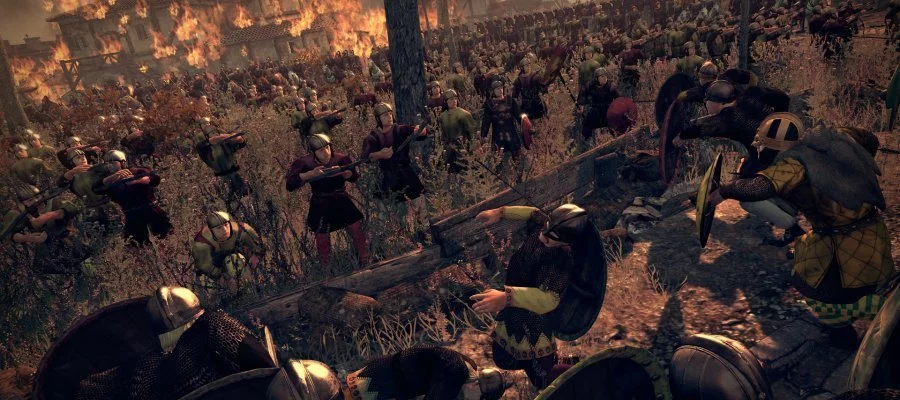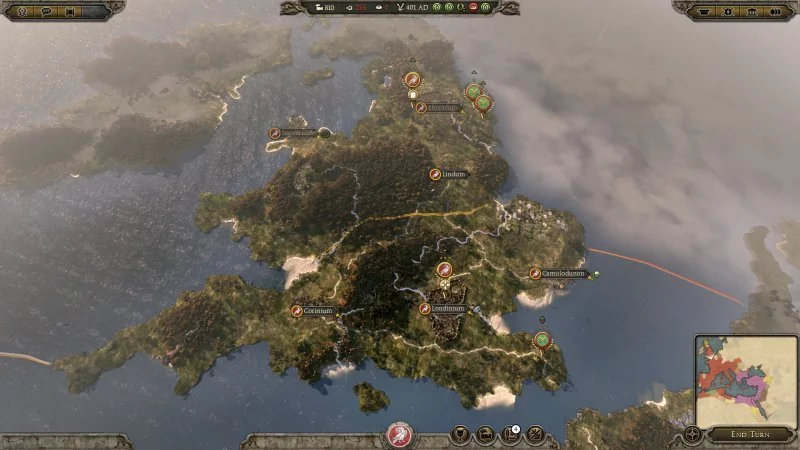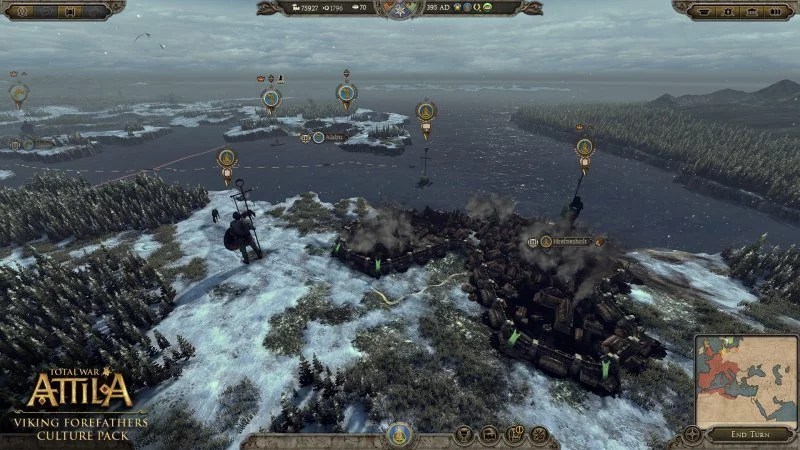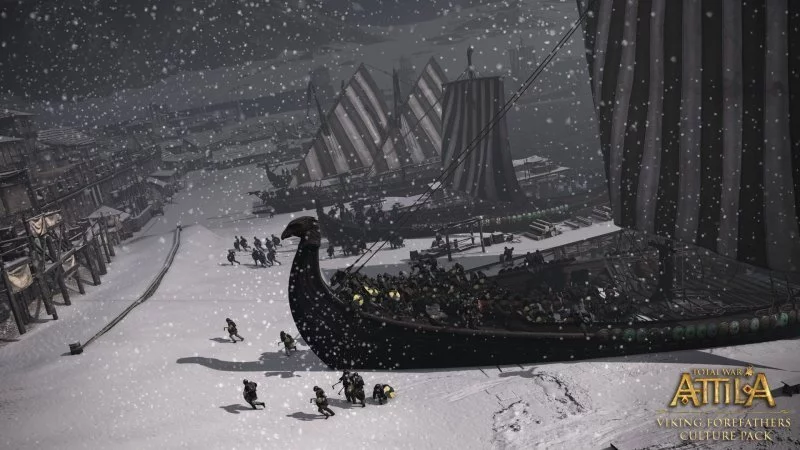The only things that can really hurt you are the things you love, like when your crush tells you that they prefer someone else or your cat tries to climb up your back when you’re shirtless. It was when Rome II’s claws dragged down my flesh and opened up small and disproportionately painful wounds that made me question whether or not continued ownership of such a thing would be good for my health.
Incidentally, I am giving away a cat.
As Attila is ‘sister/brother’ content to Total War: Rome II in the same way Fall of the Samurai is to Shogun 2, and not DLC, I’m tempted to avoid comparison altogether – but it is intensely frustrating to see how much Attila has gotten right that Rome II failed to get right patch after patch for years.
An example of this (if you’re familiar to Rome II) is the mechanics of pikes. Instead of having to get into a pike wall formation, you instead opt to get out of it – so a unit will hold their pikes high, and upon stopping, will drop their pikes forming a barrier of pointy-ness. The most expensive pike unit I’ve seen comes in around 475 talents or denarii or whatever the currency is, and while they will be summarily destroyed by whatever force catches them out of formation, they will handle themselves as a decent buffer in a front on charge, as well they should. No longer are there 1200 point units that aren’t good for anything but noob-boxes.
If you’re not familiar to Rome II, there is no example of improved mechanics that I can give which will make any sense. I’m not saying you’ve failed me, but this review is a two-way street. You can do better next time.
One of the best things about the sister content that accompanies ‘full’ releases of Total War games is that there is, to put it in incredibly vague and unclear terms, ‘something in the air’. In FotS, seeing how technology changes the landscape (like trains and train-tracks) and the military (guns > swords) puts Japan’s rapid charge into the 20th century into perspective.
Attila delivers similarly, placing your feet firmly in the European and Asian lands at the time of Rome’s fall. The migration of Germanic tribes, fleeing from the Huns, and their encounters with Roman provinces which are basically unguarded and ripe for plunder; the expansive and powerful Sassanid empire (who everyone wants to be friends with, could barely go a turn without someone offering to be my ally); and the constant and brutal raids by the Norse give the player, even unknowingly, a very good taste of what the world was going through at that time.
How do I know this? Well, I’ve been listening to Dan Carlin’s history podcasts and been reading up on my Hannibal, Alexander, and Vikings. Am I an expert? Hell no. Am I suitably intelligent enough to gain some understanding of the times and then posit whether or not Attila properly recreates them? Probably not. But for this review, I will pretend it is so.
I’ll go ahead and say this is the most accessible Total War game to date – not because it’s easier or holds your hand – but rather because it gives you the information you need when you’re looking for it. During a battle, you’re currently selected unit will be compared with all of your opponents units, showing how dangerous they are too you. Provinces now clearly indicate what resources they have, how fertile the land is, and point by point why the population feels the way it does about how you’re running your settlements. Further, the world map overlay can now be changed to show who has what religion and where, who is allied with you, and so on – for guys like me who play this semi-seriously, it adds the ability to actually plan what to do as opposed to just saying ‘f*ck it, I’ll invade that and set up shop and hope everyone in the area doesn’t try to kill me in one turn’.
There seems to be a lot more interaction between factions in this game – because of the ever-present sense of doom and turmoil, you’ll find that there are always friends to make or people willing to, at the very least, say that it’s probably not best for you two to kill each other just yet. It’s a far cry from Shogun 2 and everyone saying ‘no’ to your every reasonable request.
At this time, I’d say the AI is pretty good for what it has at its disposal. I’ve seen cavalry units go around spear units (always a good idea), seen a small army run away from me in order to meet up with its back up forces, and then reform into a coordinated larger force… but then, the CPU’s tactics seem to involve a lot of charging cavalry into my formations headlong.
But then again, the AI in Rome II would throw itself into a pike wall for no reason whatsoever. So at least it’s a step in the right direction.
I’ve played a stupid amount of PvP Total War. Shogun 2 had massive problems thanks to god damn dunderbuss and rifle cavalry, and Rome II recently turned into ‘barbarian factions win evrytim’. From what I’ve played so far, I’m really liking what’s available, because factions and units actually feel different and there seems to be no true ‘powerhouses’. Sure, there are huge similarities between the types of factions (like the migration factions, the Huns, the Viking Forefathers), each of them holds the ability to focus on at least one strength without having to rely on that one strength.
Cavalry is now a powerful and useful tool. A good cavalry unit charging into an un-braced foot unit will punish it severely, even wiping it out, which is everything cavalry should be. However, if you try to pull out a cavalry unit from an engagement you haven’t done particularly well in, you can expect massive losses. Which is as it should be.
Units seem to break and recover a lot more during combat, reminiscent of Medieval II, which make for a fairly chaotic and unpredictable battlefield.
While I may be a Viking fan, I have no problem with pointing to the Huns as my favourite faction, because it really feels like you’re using Hunnic tactics. Bows, arrows, and more bows and arrows, and hugely powerful cavalry to cycle charge enemy units over and over again. I played a historical battle against the Romans with them, and by god, I could feel how badly I was going to beat them within seconds of the match starting.
I’m seeing some major clipping online, and having a few bugs here and there in my games. During play I was unable to recruit units for some reason until I left the game and restarted. Sporadically, the game will crash (not often enough for me to point it out as a major happening, but it does occur).
As a result, I’m going to wait till I’ve played the retail copy of the game before I give a final score, but seeing how much I’ve enjoyed it so far, I’m very, very keen to see what else the game has to offer. One could say I’m Hun-gry for more.
For this portion of the review, Total War: Attila was played using a promotional copy of the game on Windows PC, as provided by the publisher.
This article may contain affiliate links, meaning we could earn a small commission if you click-through and make a purchase. Stevivor is an independent outlet and our journalism is in no way influenced by any advertiser or commercial initiative.




























